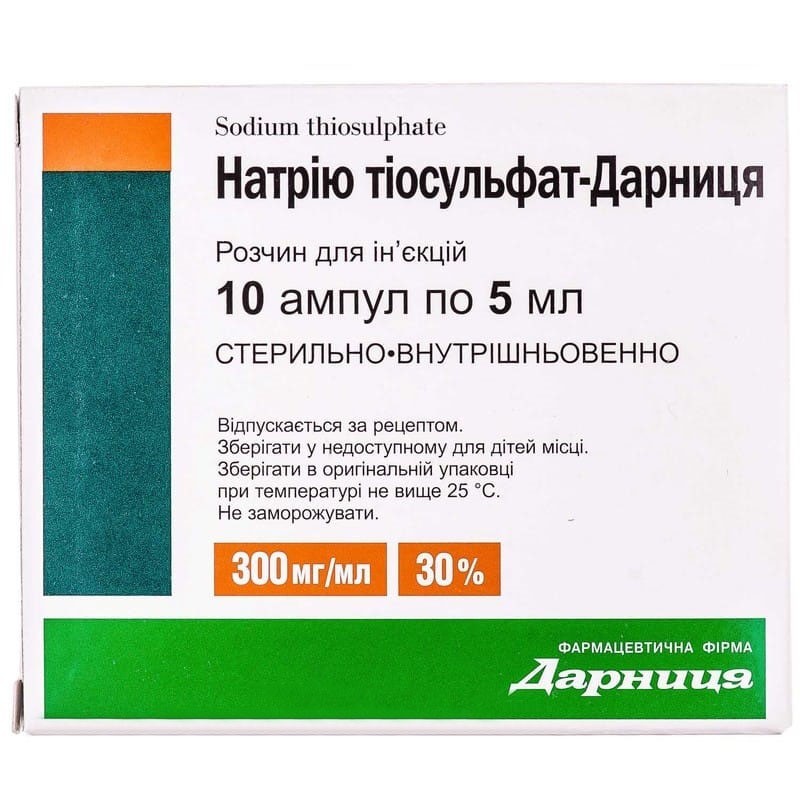



 Secure and encrypted payment processing
Secure and encrypted payment processing We ship to over 40 countries including the USA, UK, Europe, Australia and Japan
We ship to over 40 countries including the USA, UK, Europe, Australia and Japan Guaranteed refund or reship if you haven't received your order
Guaranteed refund or reship if you haven't received your orderActive substance: sodium thiosulphate;
1 ml of the solution contains 300 mg sodium thiosulfate;
excipients: sodium bicarbonate, disodium edetate, water for injection.
Injection.
Basic physical and chemical properties: transparent, colorless or slightly colored liquid.
Antidotes. code atx v03a b06.
Pharmacodynamics
Sodium thiosulfate has an antitoxic, anti-inflammatory and desensitizing effect. Is a donor of sulfur ions. It is used as a substrate by the body’s rhodanide system for the synthesis of nontoxic thio compounds. It is an antidote for poisoning with hydrocyanic acid and cyanides, arsenic, lead, mercury, iodine and bromine compounds. In case of poisoning by compounds of arsenic, mercury and lead, it forms non-toxic sulfites. In case of cyanide poisoning, forms less toxic rhodanic compounds.
Pharmacokinetics
After intravenous administration, it quickly enters the extracellular fluid, excreted unchanged in the urine. The elimination half-life is 0.65 hours.
Poisoning by compounds of arsenic, mercury, lead; hydrocyanic acid and its salts; iodine, bromine and their salts.
Hypersensitivity to the components of the drug.
Joint use with drugs, the metabolism of which passes through the stage of rhodanization, leads to a weakening of the pharmacological effects of the latter.
Drugs that are iodides, bromides, when used together with sodium thiosulfate, may not show their pharmacological properties.
Use with caution in patients with arterial hypertension, cirrhosis, congestive heart failure, renal failure, toxicosis of pregnant women, since it is possible to worsen the condition of patients.
In case of cyanide poisoning at the beginning, it is necessary to use methemoglobin formers, anticyan or amyl nitrite, and then switch to the intravenous administration of sodium thiosulfate.
Before use, it is necessary to inspect the contents of the ampoule. If sediment is present, the drug should not be used.
Patients with impaired renal function. Sodium thiosulfate, as you know, is mainly excreted by the kidneys, and the risk of developing toxic reactions to the drug may be higher in patients with impaired renal function.
Elderly patients. In elderly patients, a decrease in renal function is more likely, therefore caution should be exercised in choosing a dose and monitoring renal function.
During pregnancy or lactation, the drug can be prescribed only for health reasons.
There are no clinical data, therefore, during treatment, one should refrain from driving vehicles or working with other mechanisms that require an increased concentration of attention and the speed of psychomotor reactions.
In case of poisoning with compounds of arsenic, mercury, lead, iodine, bromine and their salts, the drug should be administered intravenously in a dose of 1.5–3 g (5–10 ml of a 30% solution). in case of poisoning with hydrocyanic acid and its salts, the drug is administered intravenously slowly at a dose of 15 g (50 ml of a 30% solution).
The drug is prescribed throughout the toxicogenic period (from the appearance of the first clinical symptoms of poisoning to the complete elimination of the toxin from the body).
Do not use the drug in children due to lack of clinical data.
Symptoms: arthralgia, hypereflexia, convulsions, psychotic behavior, including agitation, hallucinations; nausea, vomiting; increased manifestations of adverse reactions.
Treatment: hemodialysis; maintenance therapy.
From the respiratory system, chest and mediastinal organs: shortness of breath, difficulty breathing.
From the gastrointestinal tract: nausea, vomiting.
From the nervous system: headache, dizziness, impaired consciousness, tinnitus, blurred vision.
From the cardiovascular system: lowering blood pressure up to collapse, loss of consciousness, tachycardia.
From the immune system: hypersensitivity reactions, including anaphylactic reactions, arthralgia, fever.
On the part of the skin and subcutaneous tissue: itching, rash (including maculopapular), urticaria, hyperemia, sensation of heat.
General disorders and reactions at the injection site: reactions at the injection site, general weakness, increased diuresis.
3 years.
Store in the original packaging at a temperature not exceeding 25 ° C. do not freeze.
Keep out of the reach of children.
Incompatible with nitrite and nitrate solutions. Do not mix the drug in the same syringe with other drugs.
5 ml per ampoule; 5 ampoules in blister packs, 2 blister packs in a pack.
On prescription.
Ciao “Darnitsa pharmaceutical company”.
Ukraine, 02093, Kiev, st. Borispol, 13.